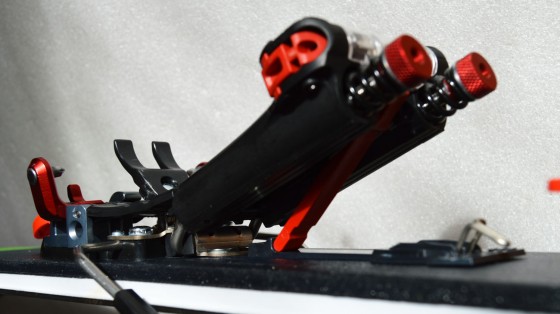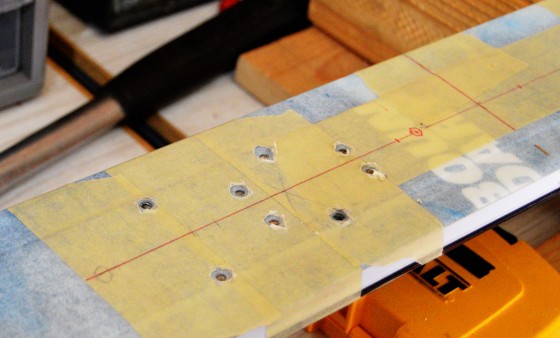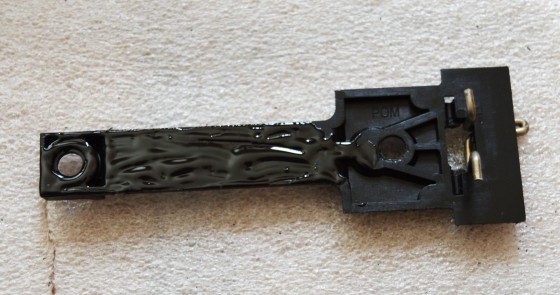If you’re mounting a Meidjo binding yourself, be aware this requires you to drill 13 holes in each ski, and that’s only if you don’t make any mistakes. Sobriety is advised. So is the Carpenter’s Rule.

Looking at what makes the Meidjo tick – for better and for worse – the magic red stub, cocked for tele turns.
Mark Boot Center
First step is to figure out where you want the boot to be, boot center on the manufacturers recommended location, or shifted backwards or forwards. I won’t digress on the logic for either. It’s your call. Wherever you decide, put masking tape on the top sheet around the toe and heel, plus a strip down the center.
Scribble on the tape
Scribe a line width-wise corresponding to where you locate the boot center on the ski, and down the center of the ski lengthwise.
Ski Centerline
I’ll suggest two ways to mark the ski center line. Doing two different methods will help to confirm an accurate center line, or make you refine your technique until you get convergence.
by compass
Method one uses a simple compass. Along the boot center line, put one arm of the compass at the edge of the ski and then scribe an arc near the toe area, one near the heel. Then move the compass to the other side, again at the edge of the ski on the boot center line, and scribe an arc from this side at the toe and heel again. Where the arcs from both sides intersect is, if you had the compass accurately anchored against the ski edge, will be the center point. Draw a line between these two points.
by center-hole jig
You could also use a jig that has posts for center holes. Position the jig with a center hole around the heel, and then around the toe. I use a Quiver Killer center punch made to work with 9mm jig posts so it leaves a mark dead center in the masking tape. Then I get a straight edge and connect the dimples.
With the ski center line and boot center line drawn take the Meidjo template and line up the ski center line and then align your boot sole length size with the boot center line. Tape it in place.
Double check that it doesn’t wiggle and is lined up correctly, then center punch the holes for the toe and shift bumper.
While you’re at it, use the heel template and mark and punch the holes for the heel post.
Drill baby, Drill!
Time for the moment of truth. Drill the toe holes — eight of ’em with a stepped drill bit. 3.6x9mm for a wood core ski, 4.1x9mm if it has a metal top sheet. If you’re super cautious, just do two corners, kiddy-corner, screw the toe down with those two and check that the boot heel is centered when locked in the pins. If it is, bravo. If it’s off, you can probably shift the remaining holes to correct it.
tap holes
I like to pre-tap the holes to make sure the screws go in straight; just go in a few threads then back it out.
When you’re ready, add some glue to the holes. Wood glue works, so does a lil’ dab o’ Gorilla glue. Epoxy might be warranted depending on the material in the ski.
Screw it down
Pierre suggested another order to assembling the parts than I show in the video above. His method would definitely be faster IFF you know what you’re doing or have the luxury of drilling holes with a jig. I wasn’t racing, nor do I suggest being impatient while mounting Meidjo. My method continues below.
Pierre’s way
He suggests mounting the shift bumper first; the black strip in the middle that the touring lock wire is connected to. Then, pre-assemble the cable rod and springs to the spring box, and place the base of the cable rod in the slot at the back of the toe baseplate. Secure the rear four screws holding the cable down. Now you can attach the metal toe piece with the pins. Be sure to insert the male end of the flexor plate into the center channel of the spring box as you position the toe over the four front holes. Screw it down. Finally, install the heel.
amateur hour
Me, I did it the amateur way (without a jig). 😉
Next I connect the cable rod at the back of the toe plate. And, if you want brakes, now is the time to add them. I didn’t bother showing the tricks in the video above.
brake diversion
Before you secure the cable remove the top metal bracket at the back of the toe baseplate. There are four small screws holding it to the plastic frame. With that removed you can slide the brake lever through the center hole and fidget a bit to get the springs set right. Then, attach the metal bracket to hold the springs and brake lever in place.
Tighten up the toe
Then I cinch all the screws down with a light torque setting with a drill. Tight enough to be snug, but not super tight. If you didn’t before, now is definitely a good time to make sure the boot is centered when clamped by the pins.
Shifter plate
Before adding the springs you want to install the shift plate (v2.0). Same routine as before: drill, tap and glue the holes but I also recommend gluing the bottom surface of the plastic because it can bow up and cause the spring box to unclip and switch to turn mode while your skinning (no need for glue with v2.1). And make sure the metal clip is properly seated in the grooves. Beware, you do not want to over tighten the screws on plastic — you might crack it. Snug with glue is good enough.
And now I’ll take a moment to give all the screws at the toe a final manual tightening to a calibrated grunt-and-a-half.
Connect spring box
It is easier to add the claw for the second heel and springs before installing the heel post. It just gets in the way of tightening the springs down. Slide the cable rod arms and dongle from the flexor plate into the spring box. Slide the springs into the back of the spring box. The red shifter stub will naturally rest on the bumper of the plastic shift plate, propping the spring box up. If you try to screw the thumb nuts on in this position you’ll be pushing against the spring which makes it hard to line up straight. It’s easier to lift the red stub over the bumper so the spring box lays flat and then you’ll be able to put the thumb nuts on without any spring tension. Waaaay easier. While you’re at it, might as well tighten them up to at least position 3 to start out.
Install the heel post
You’re almost there. Now you can finish off the mount by drilling, tapping, and gluing the holes for the heel post. I finished the screws at the heel off a light torque setting on the drill. Again, it’s plastic and I don’t want to crack it, and it doesn’t need to withstand the stresses experienced at the toe.
If all that sounds like too much work, find a shop with a jig and pay them to do it. Otherwise, just go slow while you’re marking where to drill, triple-check your work — especially the length-wise center line and the subsequent hole positions. Before drilling, line up the binding over the marks and make sure all the holes align with the actual binding screw holes.
Related Posts
Generic Installation Guide
Installing inserts
© 2017





2 comments
I photocopy the template onto an OHP sheet and then just locate that by eye. Then use an automatic centre punch.
In terms of finding the centerline of the ski, a neat trick is to take a thin strip of paper, and wrap it tightly across the ski, creasing the ends around the edges of the ski. Then remove paper, align the edge creases together, and fold the strip in half. Unfold paper, replace on ski at the same location as before, and center crease will be on the centerline of the ski. Mark center line with fine-point sharpie. Discard paper strip. Repeat process further along ski with another strip. Use a ruler to draw line connecting the two points.